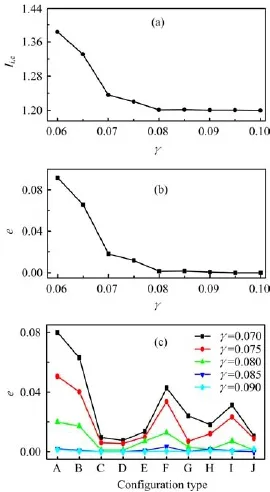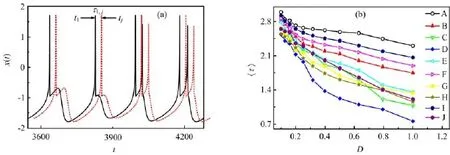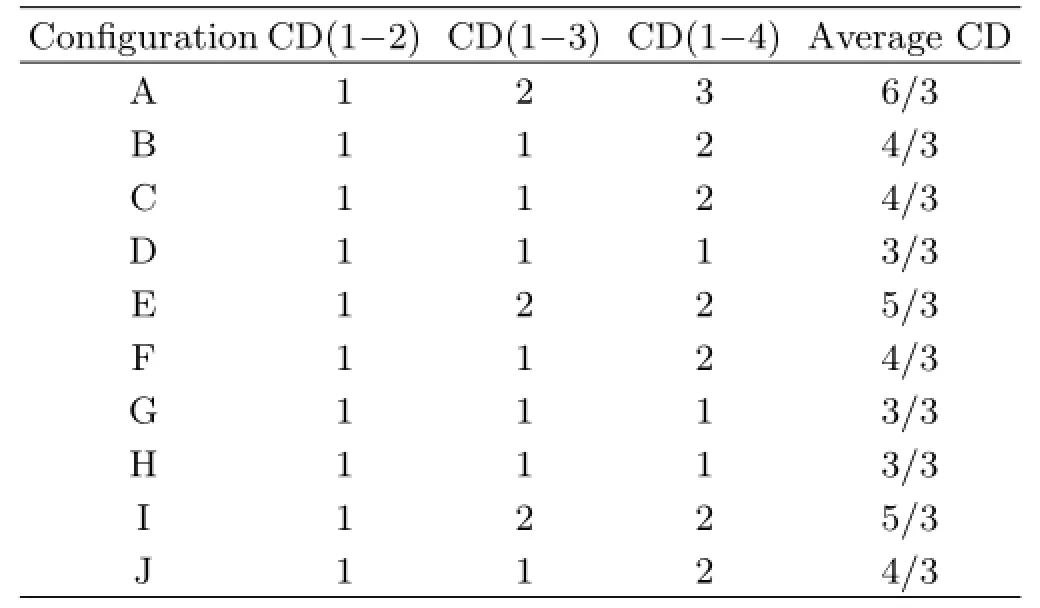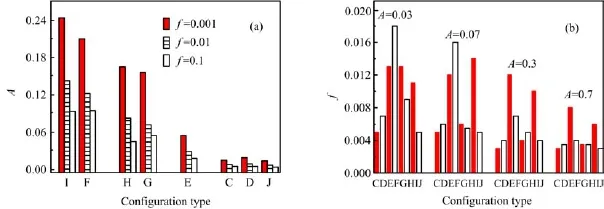Response Ability to External Signal Enhanced by Biological Spatial Configuration in Coupled Hindmarsh-Rose Neural System
Shou-fang Huang,Ji-qian Zhang,Mao-sheng WangCollege of Physics and Electronic Information,Anhui Normal University,Wuhu 241000,China(Dated:Received on May 4,2015;Accepted on September 29,2015)
Response Ability to External Signal Enhanced by Biological Spatial Configuration in Coupled Hindmarsh-Rose Neural System
Shou-fang Huang,Ji-qian Zhang∗,Mao-sheng Wang
College of Physics and Electronic Information,Anhui Normal University,Wuhu 241000,China
(Dated:Received on May 4,2015;Accepted on September 29,2015)
The effect of realistic topology configuration of intercellular connections on the response ability in coupled cell system is numerically investigated by using the Hindmarsh-Rose model. For the proper coupling intensity,we set the control parameter to be near the critical value,and the external stimulus is introduced to the first cell in coupled system.It is found that,on one hand,when the cells are coupled with some proper topological structures,the external stimulus could transmit through the system,and shows better response ability and higher sensitivity.On the other hand,the influence of topological configuration on the synchronous ability and selection effect of neural system are also discussed.Our results display that the topology of coupled system may play an important role in the process of signal propagation,which could help us to understand the coordinated performance of cells in tissue.
Hindmarsh-Rose model,Topology configuration,Response ability,Selection effect
I.INTRODUCTION
Recently,more and more attention has been focused on the dynamic processes in complex networks because of their importance in explicitly mimicking highly complex structure of many realistic systems,especially in biological neural networks[1-7].Some researchers reported that the dynamical behavior of the neuron is quite complex,which exhibits sub-threshold periodic,chaotic responses,chaotic firing of spikes,as well as mode-locked firing.These complex behaviors can be controlled by adjusting different configuration parameters under a periodic stimulation[8].Furthermore,people found the effects of external period force and noise on the controlled system,and the complexity of system can be suppressed by the slaving principle[9]. These results imply the stimuli from the internal or external environment of neuron system,may play an important role in controlling its collective activities.In recent years,some researchers found the system size and coupling strength also play a vital role in FitzHugh-Nagumo neural network[10].By controlling bifurcation parameters in the networks of Hodgkin-Huxley or Hindmarsh-Rose(HR)neurons,the transition behavior from spiral wave to other state can be induced[11,12].
Nowadays,the frontier of the research interest has focused on two kinds of collective behaviors in coupled complex systems.On one hand,the influences of the network topology on dynamical behaviors are investigated,especially the nervous system’s dynamic features[13-15].For example,the spiking oscillations show the best regularity at optimal network topology randomness[15].The introduction of small-world connections can change the second-order phase transition into a firstorder one in the 2D Ising model[16].On the other hand,how was collective dynamics of a system controlled by adjusting the parameters or introducing external stimuli.Some fascinating and important research showed the effect of system size on the dynamics behavior of system[17-19].Time delays in a network of the HR model can induce phase-flip transitions leading to synchrony or out of synchrony[20,21].
In the models mentioned above,the biological realistic cellular topology of the neural system was not considered.However,in actual tissue,even in small areas,its topological structure is significantly complicated[22-24].It was found that the topology of intercellular connections in tissue has an essential influence on calcium ions signaling[25].The geometrical factors may play a crucial role in both intra and intercellular calcium ions signaling[26].An interesting problem is whether the spatial topology is closely related with the periodic bursting behaviors in the response dynamics of the neural system or not.And how does this topology control the efficiency of signal processing in neuronal system?Thus,in this work,by using the HR model as the units,and constructing a 2D regular lattice with the nearest connections,we mainly investigate the effect of spatial topology on the signal propagation behavior of HR coupled system.
Our results really show that in a proper coupling strength region,we can observe the state-to-state tran-sition(SST)behaviors between different states,the stimulus intensity and the delay time needed by SST behavior are different in all possible configurations.
II.MODEL
The paradigmatic model used here is first proposed by Hindmarsh and Rose in 1985[27].It is originally introduced to describe the firing behavior of neurons,and qualitatively explain the bursting type with inter spike intervals of real neurons.In this work,we consider the dynamics of a system of N(N=4)coupled HR neurons,in which local coupling may correspond to the diffusion process between the nearest-neighbours,and the longrange connections to the electrical synaptic connections among non-neighbouring cells.The dynamics of an isolated HR neuron are described by three-variable differential equations as the following(for a single cell i=1 and γ=0.0).

where xiis the membrane potential,yiis a recovery variable,and ziis a slow adaptation current for the ith neuron.The constants a,b,c,d,r,s,and X0are set as a=1.0,b=3.0,c=1.0,d=5.0,s=4.0,r=0.006,and X0=-1.56,respectively.The last term in Eq.(1)denotes the coupling term for the complex neurons.γ is the coupling strength,and the indices i,j denote the cell number,Cijis the coupling parameter between the two neurons i and j.If these two neurons are coupled to each other,Cij=1,otherwise,Cij=0.In this work,we consider the case of four coupled HR neurons,in which there are ten possible different configurations A-J[23](see Fig.1),and all possible plane configurations can be distinguished with different combination of Cij.
It is well known,the bifurcation characteristic and the complex vibration modes of HR neurons are closely related to the variable Iext,so it is used as one of the control parameters to generate various firing patterns of neural network.The time series of the variable x(t)is a spike train which can display the most important coded information in neural systems.
The bifurcation property of a single neuron can be obtained by calculating the inter spike intervals of neuronal firing,in which a spike pulse in the x(t)variable is defined when the ith cell is excited so that x(t)exceeds a given threshold value x0(note that a spike occurs when the state variable x(t)is near x=1.2,so the excited threshold value x0=1.0).One can notice that from the bifurcation diagram,the complex firing activity of neuron provides a rather rich dynamical behaviors including periodic bursting state and chaotic motions[28].
In the following sections,it is reasonable and feasible to study the effects of topology connectivity on the dynamical behaviors by using the HR model.Numerical integrations of Eq.(1)are carried out using the fourthorder Runge-Kutta scheme with time step of dt=0.001. To obtain each numerical result,those beginning data of simulation are discarded and 106time steps are used.

FIG.1 Different topology structures(A-J)for 4-coulpled cells system.The external stimulus is introduced to the cell labeled by number 1.
III.RESULTS AND DISCUSSION
To investigate the effects of topological configurations on the dynamics of neural firing patterns in the 4-neuron coupling system mentioned above,and show the SST behavior,under the condition of proper coupling strength,we adjust the system parameter as the following scheme∶change topological configuration for different critical current Iext,which locals in the righthand side for each bifurcation point[28].To quantify the SST effects induced by external stimulus,the time series of output signal was analyzed and the values of the inter spike intervals versus the external current Iextare obtained.
A.Response ability to external weak signal enhanced by topology
Firstly,we consider the case that only the cell 1 is stimulated by external current,and discuss which type of configuration is more advantageous to the signal response in coupled system.To do this,we fix the coupling strength γ=0.07,and select one type of configurations(such as type H),then set the external current as Iext=1.20,the neural system may keep in the 1-periodstate.One can find,with the increasing of Iext,the external stimulus information could be propagated along this coupled chain,and all cells could turn into 2-period state successively,indicating the phenomenon of SST occurs under this condition.Similar synchronous SST behavior could be seen for other configurations.Of cause,the critical values Iextof the four cells for SST are different under the condition of certain coupling strength,so we select the critical current value of the cell which induces the system to enter the transition state as the critical standard.
To describe the response ability of the system to the external feeble signal enhanced by proper configuration,we introduce the synchronous error e of critical value by the following formula∶

where Ii,cis critical values of Iext,e can provide an indication of firing patterns transition dynamics in neural system.The smaller the current value of¯I is,the more easily the state transition occurs,also,the smaller e implies the better effect of the synchronous transition between two states.

FIG.2 Critical current values Ii,cand synchronous error e for all configurations as a function of different values of coupling strength γ for ten configuration types(A-J),when neural systems turn into 2-period state from 1-period state.(a)and(b)type H,(c)all types.a=1.0,b=3.0,c=1.0,d=5.0,s=4.0,r=0.006,X0=-1.56.
The critical current values Ii,cand synchronous error e as functions of the different coupling strength for different configuration types are depicted in Fig.2.In Fig.2(a)and(b)we could find with the increment of γ,the critical values of¯I and synchronous error e reduce continuously for a certain type of configuration. Of cause,the values of types A and B are larger than others indicating the coupled system could not transit to the 2-period state easily in these configurations.This means the 1D chain configuration is not suitable for the transition behavior.On the contrary,if cells are coupled to C,D,and J configurations,the system could jump to the 2-periodic state very easily than those in A and B(Fig.2(c)).Above results imply that the HR system may enhance its response ability to external stimulus through the mode of SST,by using proper spatial topology configuration and adjusting itself parameter.
B.Response time of SST behavior shorten by topology
To study the effects of spatial configuration on the SST behavior in coupled noisy system,so we introduce an external noise in Eq.(1),i.e.∶

where ξ(t)is Gaussian white noise with〈ξ(t)〉=0,〈ξ(t)ξ(t′)〉=D2δ(t-t′),D is the noise intensity.To discuss the transition between 1-period and 2-period states,we select the typical configurations B and D as the examples,and fix γ=0.07,Iext=1.20.Here,the external noise intensity is an adjustable parameter,other parameters are the same as the above,i.e.a=1.0,b=3.0,c=1.0,d=5.0,s=4.0,r=0.006,X0=-1.56.One can find that,when noise is introduced,and its intensity is set to be D=0.1,the system may transit to the 2-period state.We also found the SST happen quickly in cells 2 and 3 when the noise is switched on the cell 1,while cell 4 reach the same state only after a period of time,indicating there is a certain time delay in the propagation of the stimulus along the coupling system,and this time delay depends on noise intensity.Similar phenomenon can also be found in other 9 configurations. We can define this time delay τ1,jas the time interval among which the SST first appears in first cell and then transmits to the cell j(see Fig.3(a)).The mean value of time delay〈τ〉among cells in coupled system readsby the following∶

The mean delay time〈τ〉as a function of noise intensity for different configurations are depicted in Fig.3(b),from this figure,one can find that,for each configuration,the delay time decreases with increment of noise intensity,which means that the signal transmission processing could be accelerated by adjusting the noise intensity.
We also find that the mean value of delay times〈τ〉is different for ten configurations with the same noise intensity.For example,the mean delay time in configuration A is larger than that in the type D,and especially,with increment of noise intensity the mean delay time〈τ〉in the type D decreases very faster than that in other types.These results may indicate that in configuration D,the system is more advantageous to improve the response speed and response ability.
After further study,we found that,the delay time not only depends on noise intensity,but also depends on the connection distance(CD,between the stimulated cell and a given cell).For example,in configuration A,the CD between cell 2 and cell 1 is 1,while between cell 3 and cell 1 is 2.The CD between the cell 1 and the another cells in all configurations are listed in Table I.These data may provide us some useful clues to analyze the SST behavior.Obviously,in configuration D and G,the average distance is the shortest,while in configuration A the CD is longest,this difference may be the reason for that the D and G configurations are more suitable for the transmission of information than others.

FIG.3(a)Plot of time series of the membrane potentials(x(t))induced by noise in cell 1(solid lines)and cell j(dotted lines).τ1,jis the delay time between the spiking/bursting of cell 1 and cell j.(b)The mean delay time of bursting vs.noise intensity for all ten types of configurations(A-J)in four coupled cells system.

TABLE I Average distance in different topological configurations.
C.The topology influence on selection effect of system
In this work,we have also discussed the selection effect of the topology to the external signal,the corresponding dynamic equations are as follows∶

where A is the critical value of amplitude.According to the same scheme used for adjusting noise mentioned above,we first set the system to be in the 1-period state,then select the amplitude or frequency as control parameters,respectively.The distribution of inter spike intervals versus the amplitude A for a constant frequency(f=0.001)is depicted in Fig.4.It is found that,in configuration H,cell 1 is in 1-period state if A<0.003,while if A increases to 0.003,2-period state appears,indicating the SST occurs.But in the other three cells,the critical value of A is different when the SST occurs∶in cells 2,cell 3,and cell 4,A=0.152,0.154,and 0.14,respectively.Thus,to make the whole system appear SST behavior,the amplitude should be set to the maximum critical value,i.e.,A=0.154.
Similar results are also observed when we adjust the frequency,and the critical values of amplitude(or frequency)of each configuration for different frequency(or amplitude)of the external signal are depicted in Fig.4.
In Fig.4(a),it is observed that in some proper configurations(such as in C,D,and J),with the increment of f,the periodic motion in the cell 1 could transmit easily from 1-period to 2-period,indicating that SST occurs.These results suggest that some proper types of configuration(such as C and J)can enhance effectively the sensitivity of the HR system to the weak signal,implying the selection effect of topology.
We now consider some interesting configurations of four cells in detail.In configuration E and I,the disposition of cell 1,cell 3 and cell 4 is symmetrical relative to cell 2(Fig.1 E and I),and the average connection distance of coupled cell system is the same(see Table I),but the system shows different selection effect on the external signal and this difference is also manifested in weaker response in cell 3 and cell 4 in configuration E,as compared with configuration I(see Fig.4(a)and(b)).The topological difference between configurations E and I consists in the presence(E)and absence(I)of a connection between cell 3 and cell 4.This is connected with the fact that cell 3 in configuration E exchanges external signal with cell 4 in addition to cell 2,whereas there is no such exchange in configuration I.That additional exchange decreases the value of A and f in cell 3 and cell 4 when the SST occurs in configuration E.
This interesting phenomenon also takes place in other configurations.Such as in configuration G and H,the disposition of cell 2,cell 3,and cell 4 is symmetrical relative to cell 1(Fig.1 G and H),and the average connection distance of coupled cell system is the same(see Table I),but there is an additional connection between cell 3 and cell 4 in configuration G.Obviously,this additional connection makes the system show different selection effect and decreases the time delay among four cells(see Fig.3).In other words,additional connection can improve the response speed and ability of coupled cells system.

FIG.4(a)The critical value of amplitude A of each configuration for different frequency of the external signal.(b)The critical value of frequency f of each configuration for different amplitude of the external signal.
IV.CONCLUSION
We have investigated the effects of topological structures of system on the response ability to external stimulus signal in coupled HR neural system.It is found,when the controlling parameters such as the external current intensity or noise intensity are adjusted to be the critical values,and when the system is coupled to some proper configurations,SST phenomenon could appear in coupled system.This result may suggest that the neural system could improve its response ability and sensitivity to external stimulus signal by choosing suitable configuration.
We hope our results could provide some interesting information for understanding the properties of collective response behavior and mechanisms of information processing in coupled real neurobiological systems. Note that we only consider two dimensional configurations of four cells in this work.It would be interesting to consider the role of topological structure in more cells coupled system and three dimensional tissues,which is a subject of our future research.
V.ACKNOWLEDGMENTS
This work was supported by the National Natural Science Foundation and Special Found for the Theoretical Physics of China(No.21103002 and No.11047017),the Special Foundation of Education of Anhui Province for Excellent Young Scientists(No.2011SQRL023),and the Natural Science Funds of Anhui Province of China(No.1508085MA15).
[1]M.Bucolo,L.Fortuna,and M.LaRosa,Chaos,Solitons Fractals 14,1059(2002).
[2]F.Han,Q.S.Lu,M.Wiercigroch,and Q.B.Ji,Inter. J.NonLinear Mechanics 44,298(2009).
[3]H.S.Chen,J.Q.Zhang,and J.Q.Liu,Phys.A 387,1071(2008).
[4]M.S.Wang,Z.H.Hou,and H.W.Xin,Phys.Lett.A 334,93(2008).
[5]P.Wang,J.Q.Zhang,and H.L.Ren,J.Chem.Phys. 23,23(2010).
[6]L.X.Duan,Q.S.Lu,and Q.Y.Wang,Neurocomputing 72,341(2008).
[7]X.J.Sun,M.Perc,Q.S.Lu,and J.Kurths,Chaos 18,023102(2008).
[8]E.M.Izhikevich,Int.J.Bifurcation Chaos.10,1171(2000).
[9]W.Wang,Y.Wang,and Z.D.Wang,Phys.Rev.E 57,R2527(1998).
[10]D.Q.Wei,X.S.Luo,and Y.L.Zou,Commun.Theor. Phys.50,267(2008).
[11]J.Ma,C.N.Wang,W.Y.Jin,and Y.Wu,Appl.Math. Comput.217,3844(2010).
[12]C.N.Wang,J.Ma,J.Tang,and Y.L.Li,Commun. Theor.Phys.53,382(2010).
[13]O.Kwon and H.T.Moon,Phys.Lett.A 298,319(2002).
[14]M.Lin and T.L.Chen,Phys.Rev.E 71,016133(2005).
[15]Q.S.Li and Y.Gao,Phys.Rev.E 77,036117(2008).
[16]A.D.S´anchez,J.M.L´opez,and M.A.Rodriguez,Phys. Rev.Lett.88,048701(2002).
[17]A.Pikovsky,A.Zaikin,and M.A.de la Casa,Phys. Rev.Lett.88,050601(2002).
[18]Z.H.Hou,J.Q.Zhang,and H.W.Xin,Phys.Rev.E 74,031901(2006).
[19]J.Q.Zhang,C.D.Wang,M.S.Wang,and S.F.Huang,Neurocomputing 74,2961(2011).
[20]M.B.Adhikari,A.Prasad,and M.Dhamala,Chaos 21,023116(2011).
[21]M.M.Shrii,D.V.Senthilkumar,and J.Kurths,Europhys.Lett.98,10003(2012)
[22]J.H.Evans and M.J.Sanderson,Am.J.Physiol.277,L30(1999).
[23]H.Niessen,H.Harz,P.Bedner,K.Kramer,and K. Willecke,J.Cell Sci.113,1365(2000).
[24]M.V.L.Bennett and V.K.Verselis,Semin.Cell.Biol. 3,29(1992).
[25]I.V.Dokukina,M.E.Gracheva,E.A.Grachev,and J. D.Gunton,Phys.D 237,745(2008).
[26]K.Tsaneva-Atanasova,D.I.Yule,and J.Sneyd,Biophys.J.88,1535(2005).
[27]J.L.Hindmarsh and R.M.Rose,Proc.R.Soc.London Ser.B 221,87(1984).
[28]S.F.Huang,J.Q.Zhang,and S.J.Ding,Chin.Phys. Lett.26,050502(2009).
∗Author to whom correspondence should be addressed.E-mail:zhangcdc@mail.ahnu.edu.cn
 CHINESE JOURNAL OF CHEMICAL PHYSICS2016年2期
CHINESE JOURNAL OF CHEMICAL PHYSICS2016年2期
- CHINESE JOURNAL OF CHEMICAL PHYSICS的其它文章
- Incorporation of Reactive Corrosion Inhibitor in Waterborne Acrylic Polyurethane Coatings and Evaluation of its Corrosion Performance
- Synthesis and Surface Activity of Heterogemini Imidazolium Surfactants
- Substituent Effects on Reduction Potentials of Meta-substituted and Para-substituted Benzylideneanilines
- Preparation of Nitrogen-Doped Carbon Catalyst to Oxygen Reduction Reaction and Influence of Protective Gas Flowing on Its Activity
- Structural and Magnetic Properties of Chemically Synthesized Pd-Modified NiFe2O4Nanoparticles
- Fast Photodegradation of Malachite Green using Nano-ZnO on Ceramic MgAl Carbonate Layered Double Hydroxides Support
